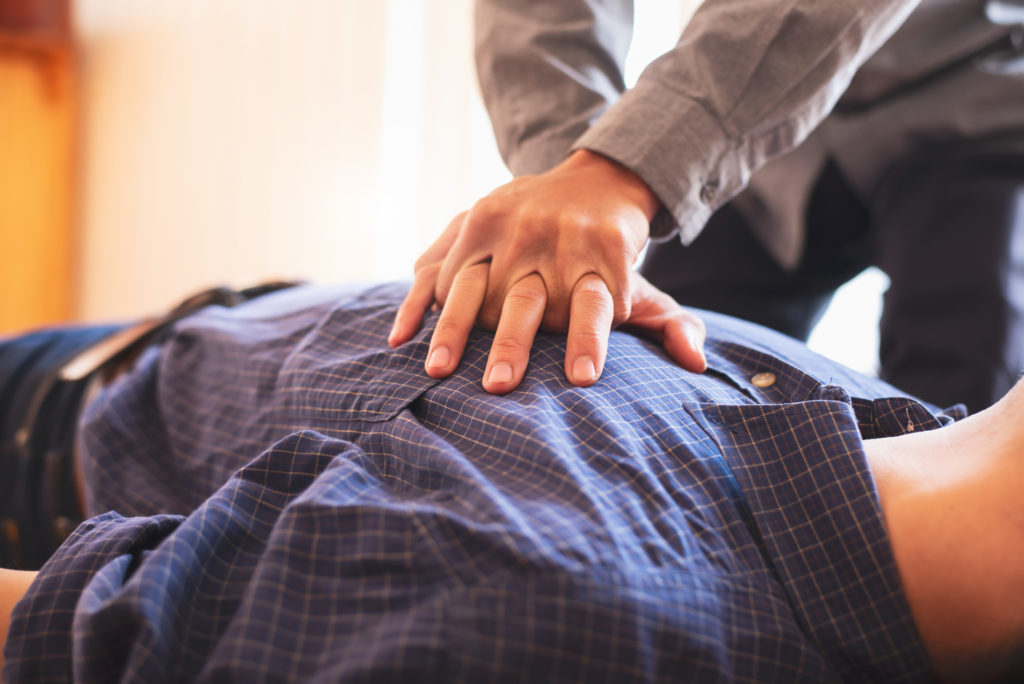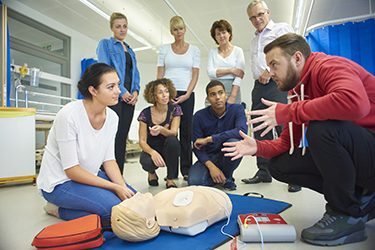eSSENTIAl SKILLS

Travelers, especially those who engage in outdoor pursuits in remote areas, may need to stabilize and deliver care to an injured companion before medical assistance arrives. Major medical publications provide instruction in greater detail, but the following text provides a distillation of the essential points.
Providing First Aid
The following are the key steps for helping individuals who have been injured but are still responsive (conscious and aware):
- Maintain and/or assist with airway control.
- Control severe bleeding.
- Prevent shock or administer treatment for it.
Individuals who are breathing but unresponsive should be assumed to be in respiratory failure (respiratory insufficiency) — that is, having an inadequate exchange of oxygen for carbon dioxide. For these individuals, immediately do the following:
- Protect their airway.
- Carefully monitor them to determine if they require artificial respiration such as CPR.
If individuals are unresponsive and show no signs of life — no breathing, movement or response to an attempt to rouse them — immediately start chest compressions. Anyone can safely perform CPR, with or without training.
Administering CPR
For individuals who are unresponsive and not breathing, the crucial priority is to reestablish their circulation. The American Heart Association (AHA) uses the mnemonic “CAB” in its CPR guidelines as a reminder for the most effective order of steps for administering CPR: compressions, airway and breathing.
- Compressions: Push hard and fast on the center of the victim’s chest. Using the heel of your hand, press down about 2 inches at a rate of at least 100 compressions per minute (more than one per second), letting the chest rise fully after each compression. After every 30 compressions, give two rescue breaths.
- Airway: Tilt back the victim’s head and lift the chin to open the airway.
- Breathing: Give mouth-to-mouth rescue breaths. Pinch shut the victim’s nose, cover his or her mouth with your mouth, and blow until you see the chest rise. Give two breaths, taking about one second for each breath. Then administer another 30 chest compressions. Minimize delay between compressions and rescue breaths. CPR barrier masks and devices are available to provide protection when delivering rescue breaths.
Anyone, regardless of training, can safely perform chest compressions, now often called hands-only CPR. As the AHA says, “Any attempt at
CPR is better than no attempt.” Learn more about hands-only CPR at
CPR.Heart.org/En/CPR-Courses-and-Kits/Hands-Only-CPR.
- Although administering chest compressions and/or rescue breathing in a remote location can be difficult, if a victim is in cardiac arrest, continue chest compressions with minimal interruption until the following occurs:
- The victim’s circulation has been restored and they are moving, breathing and speaking normally.
- Emergency medical care is available.
- Those present are unable to continue due to exhaustion or conditions that place them at risk.
- Reliable criteria indicates irreversible death is present.
— The victim has not been restored to spontaneous circulation after three full rounds of CPR and automated external defibrillator (AED) analysis. An AED is a device that analyzes the heart’s rhythm and, if appropriate, delivers a shock to try to restore its normal rhythm.
— Three consecutive AED analyses have resulted in no shocks.
— Advanced life support (ALS), if available, has been administered but has not resulted in spontaneous circulation restoration.
For more information about CPR and current AHA guidelines, see cpr.heart.org.
Learning the full CPR procedures is not difficult, but it requires training and practice with qualified instructors. This guide is not a substitute for such instruction. Even if you have had CPR training, review your course manual’s basic steps before a trip, especially if you’ll be going to a remote area. Consider taking a refresher course to ensure your skills are current.

Learn more about hands-only CPR at
CPR.Heart.org/En/CPR-Courses-and-Kits/Hands-Only-CPR.


The American Heart Association (AHA) uses the mnemonic “CAB” in its CPR guidelines as a reminder for the most effective order of steps for administering CPR: compressions, airway and breathing.
DAN Customer Service
Mon–Fri, 8:30 a.m. – 5 p.m. ET
+1 (919) 684-2948
+1 (800) 446-2671
Fax: +1 (919) 490-6630
24/7 Emergency Hotline
In event of a dive accident or injury, call local EMS first, then call DAN.
24/7 Emergency Hotline:
+1 (919) 684-9111
(Collect calls accepted)
DAN must arrange transportation for covered emergency medical evacuation fees to be paid.
Medical Information Line
Get answers to your nonemergency health and diving questions.
Mon–Fri, 8:30 a.m. – 5 p.m. ET
+1 (919) 684-2948, Option 4
Online: Ask A Medic
(Allow 24-48 hours for a response.)